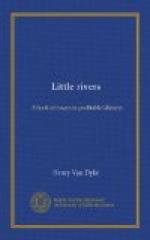If you could paint a picture of Memory, in the symbolical manner of Quarles’s Emblems, it should represent a man travelling the highway with a dusty pack upon his shoulders, and stooping to draw in a long, sweet breath from the small, deep-red, golden-hearted flowers of an old-fashioned rose-tree straggling through the fence of a neglected garden. Or perhaps, for a choice of emblems, you would better take a yet more homely and familiar scent: the cool fragrance of lilacs drifting through the June morning from the old bush that stands between the kitchen door and the well; the warm layer of pungent, aromatic air that floats over the tansy-bed in a still July noon; the drowsy dew of odour that falls from the big balm-of-Gilead tree by the roadside as you are driving homeward through the twilight of August; or, best of all, the clean, spicy, unexpected, unmistakable smell of a bed of spearmint—that is the bed whereon Memory loves to lie and dream!
Why not choose mint as the symbol of remembrance? It is the true spice-tree of our Northern clime, the myrrh and frankincense of the land of lingering snow. When its perfume rises, the shrines of the past are unveiled, and the magical rites of reminiscence begin.
I.
You are fishing down the Swiftwater in the early Spring. In a shallow pool, which the drought of summer will soon change into dry land, you see the pale-green shoots of a little plant thrusting themselves up between the pebbles, and just beginning to overtop the falling water. You pluck a leaf of it as you turn out of the stream to find a comfortable place for lunch, and, rolling it between your fingers to see whether it smells like a good salad for your bread and cheese, you discover suddenly that it is new mint. For the rest of that day you are bewitched; you follow a stream that runs through the country of Auld Lang Syne, and fill your creel with the recollections of a boy and a rod.
And yet, strangely enough, you cannot recall the boy himself at all distinctly. There is only the faintest image of him on the endless roll of films that has been wound through your mental camera: and in the very spots where his small figure should appear, it seems as if the pictures were always light-struck. Just a blur, and the dim outline of a new cap, or a well-beloved jacket with extra pockets, or a much-hated pair of copper-toed shoes—that is all you can see.
But the people that the boy saw, the companions who helped or hindered him in his adventures, the sublime and marvellous scenes among the Catskills and the Adirondacks and the Green Mountains, in the midst of which he lived and moved and had his summer holidays—all these stand out sharp and clear, as the “Bab Ballads” say,
“Photographically
lined
On the tablets of your
mind.”
And most vivid do these scenes and people become when the vague and irrecoverable boy who walks among them carries a rod over his shoulder, and you detect the soft bulginess of wet fish about his clothing, and perhaps the tail of a big one emerging from his pocket. Then it seems almost as if these were things that had really happened, and of which you yourself were a great part.




